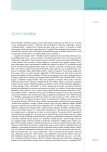Neural control of the lower urinary tract
Authors:
Jan Krhut 1; Roman Zachoval 2
Authors‘ workplace:
Urologické oddělení FN, Ostrava-Poruba
1; Urologické oddělení FTN, Praha
2
Published in:
Ces Urol 2011; 15(2): 69-77
Category:
Review article
Overview
Neural control of the lower urinary tract function is a complex and complicated process performed on several levels. The principles of peripheral inervation of the lower urinary tract are relatively well-known to urologists. However, central control mechanisms are known to a rather small number of urologists, even though the consequences of their disorder are encountered in the urological practice on a daily basis. In the last two decades the studies of the brain using the positron emission tomography and the functional magnetic resonance contributed to understanding of the control structures and mechanisms of the micturition cycle on the brain level. Owning to these methods, a basic structure model of functional control of a micturition cycle could have been formed. The objective of this article is to introduce a contemporary view on the neural control of the lower urinary tract to urologists with an emphasis on the function of central structures.
Key words:
brain, spinal cord, sympathetic nerves, parasympathetic nerves, myovesical plexus, prefrontal cortex
Sources
1. Blok B, Willemsen T, Holstege G. A PET study of brain control of micturion in humans. Brain
1997; 120: 111–121.
2. Hanuš T. Farmakologické ovlivnění dynamiky dolních močových cest. Rozhl Chir 1982; 61(1):
42–46.
3. Das AK, Leggett RE, Whitbeck C, et al. Effect of doxazosin on rat urinary bladder function
after partial bladder obstruction. Neurourol Urodyn. 2002; 21(2): 160–166.
4. Andersson KE, Wein AJ. Pharmacology of the lower urinary tract. Basis for current and future
treatments of urinary incontinence. Pharmacol Rev 2004; 56(4): 581–631.
5. Habler HJ, Janig W, Koltzenburg M. Activation of unmyelinated afferent fibres by mechanical
stimuli and inflammation of the urinary bladder in the cat. J Physiol 1990; 425: 545–562.
6. Apostolidis A, Popat R, Yiangou Y, et al. Decreased sensory receptors P2X3 and TRPV1 in
suburothelial nerve fibers following intradetrusor injections of botulinum toxin for human
detrusor overactivity. J Urol 2005; 174(3): 977–982.
7. de Seze M , Wiart L, de Seze MP, et al. Intravesical capsaicin versus resiniferatoxin for the treatment
of detrusor hyperreflexia in spinal cord injured patients: a double-blind, randomized,
controlled study. J Urol 2004; 171(1): 251–255.
8. Griffiths D, Tadic SD. Bladder control, urgency and urge incontinence: evidence from functional
brain imaging. Neurourol Urodyn 2008; 27; 466–474.
9. Drake MJ, Fowler CJ, Griffiths D, et al. Neural control of the lower urinary and gastrointestinal
tracts: supraspinal CNS mechanism. Neurourol Urodyn 2010; 29: 119–127.
10. Fowler CJ, Griffiths DJ. A decade of functional brain imaging applied to bladder control Neurourol
Urodyn 2010; 29: 49–55.
11. Ramage AG. The role of central 5-hydroxytryptamine (5-HT, serotonin) receptors in the control
of micturition. Br J Pharmacol 2006; 147(Suppl 2): 20–31.
12. Gillespie JI. The autonomous bladder: a view of the origin of bladder overactivity and sensory
urge. BJU Int 2004; 93(4): 478–483.
13. Drake MJ. The integrative physiology of the bladder. Ann R Coll Surg Engl 2007; 89: 580–585.
Labels
Paediatric urologist Nephrology UrologyArticle was published in
Czech Urology

2011 Issue 2
Most read in this issue
- Lichen sclerosus – commonly overlooked urological diagnosis with serious complications
- Neural control of the lower urinary tract
- Impalpable testis, what first: diagnostic laparoscopy or inguinal exploration?
- Carbonic anhydrase IX (CA IX) expression in renal cell carcinoma and transitional cell carcinoma of urinary tract
